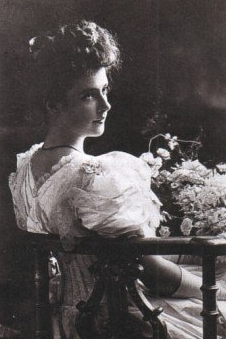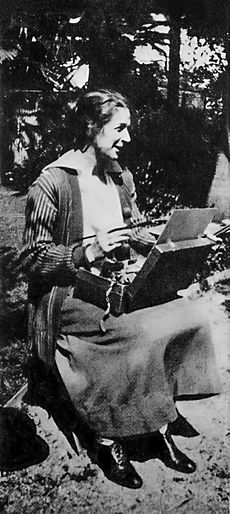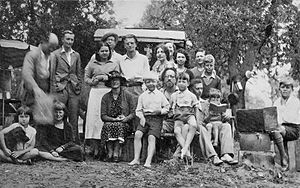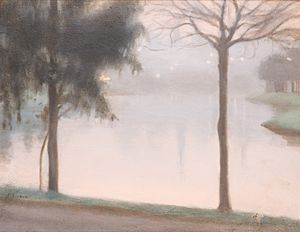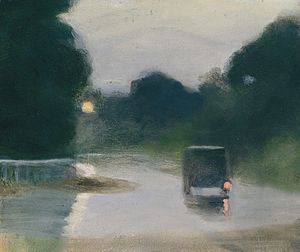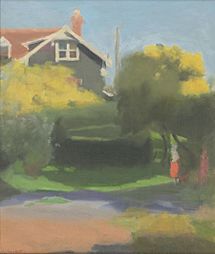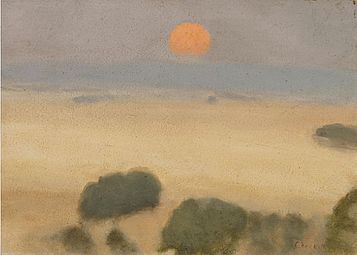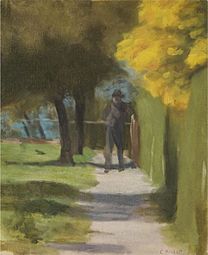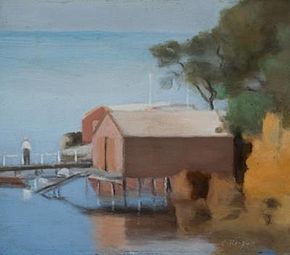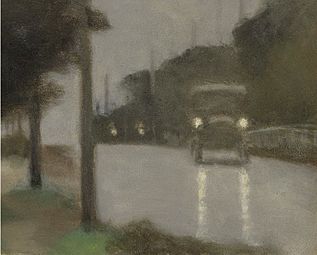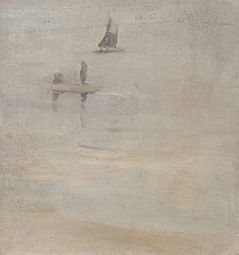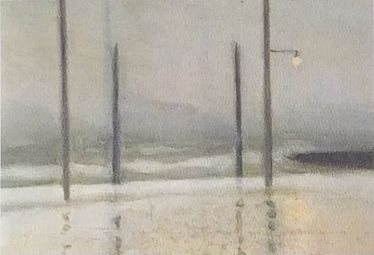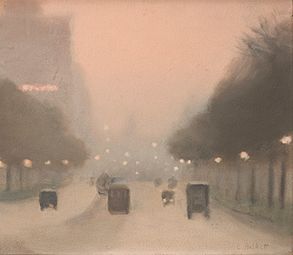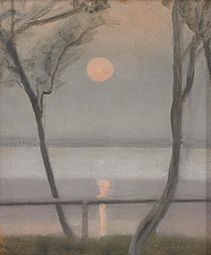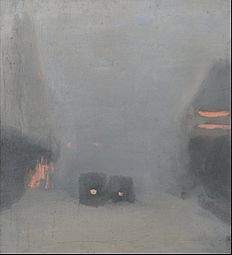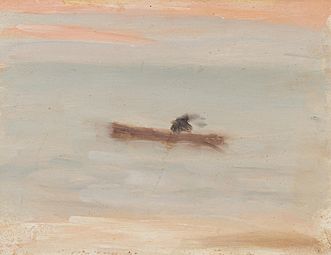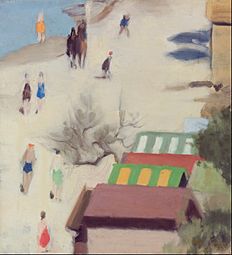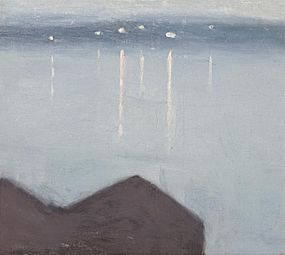Clarice Beckett facts for kids
Quick facts for kids
Clarice Beckett
|
|
|---|---|
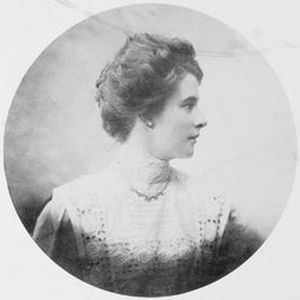 |
|
| Born |
Clarice Marjoribanks Beckett
21 March 1887 Casterton, Victoria, Australia
|
| Died | 7 July 1935 (aged 48) Melbourne, Victoria, Australia
|
| Nationality | Australian |
| Education |
|
| Known for | Painting |
| Movement | Australian tonalism |
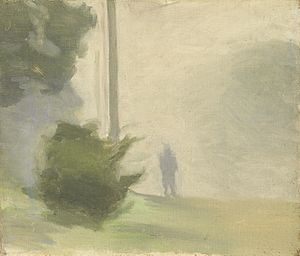
Clarice Marjoribanks Beckett (born March 21, 1887 – died July 7, 1935) was an important Australian artist. She was a key part of the Australian tonalist art movement.
Beckett was famous for her soft, misty paintings of Melbourne and its suburbs. She created her own special style. This style is now seen as an early step towards modern art in Australia. During her life, many people in the art world didn't appreciate her work. She was mostly forgotten for many years after she died. But today, she is known as one of Australia's greatest artists.
Clarice was born and grew up in Casterton, a country town. People thought she was very shy, but also smart and good at art. In 1914, her family moved to Melbourne. She then studied art for three years at the National Gallery School. Her teacher was Frederick McCubbin, a famous Australian impressionist painter. After that, she spent nine months at another art school. This school was run by Max Meldrum, who had his own ideas about painting. He taught a "tonalist" system based on scientific rules.
Beckett and other artists who followed Meldrum's ideas started showing their art together in 1919. Critics sometimes called them "Meldrumites." Clarice also showed her work with the Twenty Melbourne Painters Society. She had her first solo art show in 1923. She would go on to have ten solo shows in total.
Clarice Beckett never left Victoria and rarely traveled far from Melbourne. She spent much of her adult life looking after her sick parents at their home in Beaumaris. Even with her family duties, she painted a lot. She often painted en plein air (outdoors) around Beaumaris. She usually painted at dawn or dusk. These were the times when she was free from housework.
Beckett used Meldrum's methods and painted everyday scenes. But her art also had a special emotional and spiritual feeling. This showed her interest in Buddhism, Theosophy, and the ideas of Freud. By 1926, her landscapes were very simple and new for Australian art. From 1930, she tried new things with brighter colors and interesting designs. In 1935, she was painting the sea during a winter storm. She caught pneumonia and died four days later. She was 48 years old.
Sadly, many of Beckett's paintings were lost after she died. Her father destroyed some he thought were "unfinished." Others were lost in a bushfire. In 1970, about two thousand of her works were found in an old shed. Most of them were ruined by the weather. The paintings that survived were shown in Melbourne the next year. This led to a new interest in Clarice Beckett's art. Now, her paintings are in Australia's national and state art galleries. She is seen as a very important artist.
Contents
Life Story
Growing Up and Learning Art
Clarice Beckett was born in 1887 in Casterton, Victoria. She was the oldest daughter of Elizabeth Kate and Joseph Clifden Beckett. Her father was a bank manager and an organist.
Clarice went to primary school in Casterton. For high school, she went to Queen's College in Ballarat until 1903. There, she showed a strong talent for drawing. She even wrote a play that the students performed. She also took private drawing lessons.
Later, her family moved to South Yarra in Melbourne. She finished her last year of school at Melbourne Church of England Girls' Grammar School. In 1914, she started studying art at the National Gallery School in Melbourne. She studied for three years with Frederick McCubbin. Then, she continued her studies with Max Meldrum. His unique ideas about art greatly influenced her own painting style.
In 1919, her parents moved to Beaumaris, a bayside suburb of Melbourne. They bought a house called St. Enoch's.
As her parents got older and sicker, Clarice took on more household duties. This limited her time for art. However, she still joined other tonalist artists on painting trips. They went to places like Eltham, Olinda, and coastal towns like Anglesea and Lorne. Her paintings show these beautiful locations. At home in Beaumaris, Clarice could only paint outdoors at dawn or dusk. The rest of her day was spent caring for her parents. Her mother became very ill in 1932 and died in 1934. After her mother's death, Clarice's father destroyed some of her paintings. He thought they were "unfinished." He died in 1936.
Australian Tonalism Explained
After joining Meldrum's school, Clarice Beckett started using his special painting system. This led to a style called Australian tonalism. This style is known for its "misty" or hazy look. Artists created this by building up layers of "tone" (lightness and darkness). Meldrum believed art should be like science. He thought artists should only paint the first impressions their eyes received. They should not add extra details or stories.
The Australian tonalists did not like impressionism or modern art styles. Their ideas caused a lot of debate. Other artists sometimes made fun of them, calling them "Meldrumites." One famous artist, George Bell, said Australian Tonalism made everything look "muffled" and "dense."
Clarice Beckett painted very often and with great care. She used Meldrum's ideas to paint scenes outdoors. She was very productive, holding a solo show every year from 1923 to 1933. She painted beaches, country areas, and city scenes. She often captured the special light of early mornings or evenings.
At first, art critics had mixed feelings about her paintings. Some found them "opaque" (not clear). One critic wrote that her paintings made Australia look like it was "in a continual state of fog." But over time, some critics began to praise her work. Her friend and fellow artist, Percy Leason, said her paintings showed a "convincing illusion of actual space and air and light."
Meldrum himself once said there would never be a great woman artist. But he saw Clarice as his most talented student. He said she "worked like a man" and that her work was "of which any nation would be proud." He even called her a "great artist."
Her Modern Style
Clarice Beckett's paintings started to move beyond Meldrum's strict rules. She began to use color more boldly. While Meldrum thought modern artists cared too much about color, Clarice found her own way. Her art was a mix of Meldrum's ideas and her own unique way of seeing light, shape, and color.
Rosalind Hollinrake, who helped bring Beckett's art back into public view in the 1970s, noticed her later works used color to make shapes stronger. They also had more daring designs. In 1971, critic Patrick McCaughey called Beckett a "remarkable modernist." He put her on the same level as other important modern Australian artists like Grace Cossington Smith and Margaret Preston. He said she was both a "Meldrumite and a pioneering modernist."
Artist and critic Nancy Borlase wrote that Beckett's simple style seemed to predict the work of artists like Barnett Newman many years later. She also noted that "solitude and stillness" were key themes in Beckett's art.
Her Death
In 1935, Clarice Beckett was painting the sea near Beaumaris during a storm. She caught pneumonia and died four days later. She was 48 years old. She was buried in Cheltenham Memorial Park.
Her Art and How She Painted

Clarice Beckett wrote down her goals for her art in 1924. This is the only known statement she made about her work. She said she wanted:
- To show the true beauty of nature.
- To capture the charm of light and shadow.
- To use correct tones to make her paintings look as real as possible.
Clarice was good at painting portraits and still life (like flowers), which her teacher Meldrum liked. But she preferred to paint landscapes outdoors by herself. She often painted scenes from the Beaumaris area where she lived. She was one of the first artists in Meldrum's group to use a special painting trolley. This made it easier for her to paint in different outdoor spots.
Her Lasting Impact
During her lifetime, Clarice Beckett's paintings were not in any public art collections in Australia. But after her death, her sister and a friend donated some of her works to art museums. Now, almost every major Australian art gallery has her paintings. The National Gallery of Australia bought eight of her works in 1971. The artist Fred Williams suggested they buy them. He said she was "ahead of her time." By 2001, her paintings were selling for very high prices at auctions.
In 1936, a special memorial exhibition was held for Beckett in Melbourne. Her sister and father organized it. In 1971, Clarice's sister told Rosalind Hollinrake a sad story. More than 2,000 of Clarice's paintings had been left in an open shed near Benalla. Most of them were ruined by the weather and animals. However, about thirty well-preserved works were found at an artist colony called Montsalvat. These had been sent there when her Beaumaris home was cleared out.
After this discovery, five art shows of Beckett's work were held between 1971 and 1980. The first museum show of her art was in 1995. A big exhibition called "Politically incorrect: Clarice Beckett" toured eight national galleries from 1999 to 2000.
In 2021, the Art Gallery of South Australia held a large exhibition called "Clarice Beckett: The Present Moment." It showed 160 of her works, including a portrait that had been lost for a long time. This show was very popular and had the most visitors of any solo exhibition in the museum's history.
Clarice Beckett is remembered in several ways. There is a lane named 'Clarice Beckett's Lane' in Black Rock. A part of the City of Bayside is called Beckett Ward. Ballarat Grammar School, where she studied, gives an annual Clarice Beckett Prize for art students. A crater on the planet Mercury was also named Beckett in her honor in 2008.
Selected Paintings
Exhibitions
Solo Exhibitions
- 1923 June, Athenaeum Gallery
- 1924 September, Athenaeum Gallery
- 1925 July, Athenaeum Gallery
- 1926 July 20–31, Athenaeum Gallery
- 1927 September, Athenaeum Gallery
- 1928 July, Athenaeum Gallery
- 1929 November, Athenaeum Gallery
- 1930 October, Athenaeum Gallery
- 1931 October, Athenaeum Gallery (show opened by Max Meldrum)
- 1932 March, The Meldrum Gallery
- 1932 October, Athenaeum Gallery
- 1933 November, The Meldrum Gallery
Group Exhibitions
- 1918 May, Victorian Artists' Society Autumn Exhibition, East Melbourne
- 1918 September, Victorian Artists' Society Spring Exhibition, East Melbourne
- 1919 September, A Meldrum Group, Athenaeum Gallery
- 1920 June, A Meldrum Group, Athenaeum Gallery
- 1921 May, A Meldrum Group, Athenaeum Gallery
- 1922 May, Victorian Artists' Society Autumn Exhibition, East Melbourne
- 1922 November, Victorian Artists' Society Spring Exhibition, East Melbourne
- 1923 April, Victorian Artists' Society Autumn Exhibition, East Melbourne
- 1923 July, Twenty Melbourne Painters, Athenaeum Gallery
- 1923 October, Victorian Artists' Society Spring Exhibition, East Melbourne
- 1924 May, Twenty Melbourne Painters, Athenaeum Gallery
- 1925 September, Twenty Melbourne Painters, Athenaeum Gallery
- 1926 September, Twenty Melbourne Painters, Athenaeum Gallery
- 1926 December, Women's Art Club, Athenaeum Gallery
- 1927 July, Women's Art Club, Athenaeum Gallery
- 1927 September, Twenty Melbourne Painters, Athenaeum Gallery
- 1928 September, Twenty Melbourne Painters, Athenaeum Gallery
- 1928 October, Melbourne Society of Women Painters, Athenaeum Gallery
- 1929 September, Twenty Melbourne Painters, Athenaeum Gallery
- 1929 October, Melbourne Society of Women Painters, Athenaeum Gallery
- 1930 September, Twenty Melbourne Painters, Athenaeum Gallery
- 1930 October, Melbourne Society of Women Painters, Athenaeum Gallery
- 1931 September, Twenty Melbourne Painters, Athenaeum Gallery
- 1931 October, Melbourne Society of Women Painters, Athenaeum Gallery
- 1931 First Contemporary All-Australian Art Exhibition, at the International Art Centre of the Roerich Museum, New York
- 1932 September, Twenty Melbourne Painters, Athenaeum Gallery
- 1933 March, Meldrum Gallery
- 1933 September, Twenty Melbourne Painters, Athenaeum Gallery
- 1934 September, Twenty Melbourne Painters, Athenaeum Gallery
- 1934 October, A Meldrum Group, Athenaeum Gallery
Selected Posthumous Exhibitions
- 1936 Athenaeum Gallery (Memorial Exhibition)
- 1971-2 Homage to Clarice Beckett (1887–1935) : Idylls of Melbourne and Beaumaris. Rosalind Humphries Galleries, Melbourne
- 1973 "Clarice Beckett", David Sumner Galleries, Adelaide
- 1975 Macquarie Galleries, Sydney
- 1978 Clarice Beckett 1887-1935, 58 Wattle Valley Road, Canterbury, 29 October
- 1979 Realities, Melbourne (Retrospective Exhibition)
- 1979 Macquarie Galleries, Sydney, accompanying launch of Rosalind Hollinrake's book Clarice Beckett–The Artist and Her Circle
- 1980 Gallery Huntly, Canberra
- 1995 "In a Certain Light" (with Olive Cotton), The University of New South Wales Ivan Dougherty Gallery, Sydney
- 1999–2000 "Politically incorrect: Clarice Beckett" A retrospective touring exhibition organised by The lan Potter Museum of Art, University of Melbourne:
- Ian Potter Museum of Art, The University of Melbourne, Melbourne, Victoria: 5 February 1999 – 28 March 1999
- S. H. Ervin Gallery (National Trust of Australia NSW), Sydney, NSW: 24 April 1999 – 13 June 1999
- Orange Regional Gallery, Orange, NSW: 19 June 1999 – 18 July 1999
- Art Gallery of South Australia, Adelaide SA: 6 August 1999 – 19 September 1999
- Bendigo Art Gallery, Bendigo, Victoria: 30 September 1999 – 31 October 1999
- Art Gallery of Ballarat, Ballarat, Victoria: 5 November 1999 – 16 January 2000
- Tasmanian Museum and Art Gallery, Hobart, Tasmania: 3 February 2000 – 26 March 2000
- Burnie Regional Art Gallery, Burnie, Tasmania: 7 April 2000 – 22 May 2000
- 2000ff: Niagara Galleries, Melbourne has held three survey exhibitions of Beckett's work in 2000, 2002 and 2014.
- 2021 "Clarice Beckett: The present moment" Art Gallery of South Australia, Adelaide SA: 27 February – 16 May


